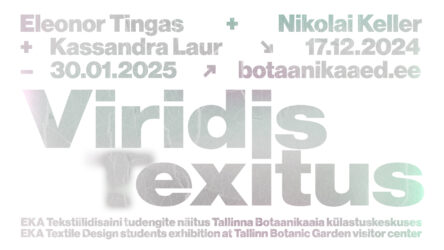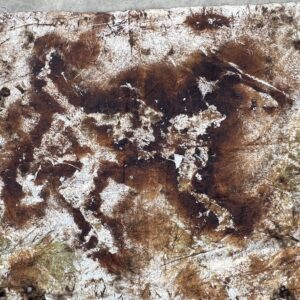Tallinn Botanical Garden's visiting centre
Start Date:
17.12.2024
Start Time:
17:00
End Date:
30.01.2025

Students of the Estonian Academy of Arts will open the exhibition of experimental printed fabrics “Viridis (T)exitus / Green (T)exit” at the Tallinn Botanical Garden Visitor Center on December 16 at 5:00 PM.
17.12.2024–30.01.2025
Kassandra Laur, Eleonor Tingas and Nikolai Keller, 3rd year students of the EKA Textile Design department, will present experimental textile works inspired by processes, rhythms and textures occurring in nature.
The three artists, having different life experiences and approaches, experiment with nature-inspired processes, rhythms, and textures, telling stories of myths, life traces, and future urban biodiversity. The works on display reflect dialogues between natural forms, urban space, and human creativity. The young artists use experimental techniques to offer their personal interpretation of natural processes. These works offer an opportunity for stillness, opening a door for the discovery of three artistic visions. We welcome you to discover nature along with the authors.
The experimental printed textiles were created in the course Printed Textile Design 2, supervised by Lylian Lainoja and Piret Valk. Digital printing was done by Kiustuudio. We would like to thank Maria Erikson, head of the EKA graphics workshop, and Taavi Teevet, head of the metal workshop. Graphic design by Diana Tammets
The textile design specialty, which celebrates its 110th anniversary this year, is part of the EKA BA curriculum Fashion, Textile and Accessory Design.
https://www.artun.ee/en/curricula/textile-design/
Kassandra Laur‘s lithography print “Ubinapuud” (Apple Trees) is inspired by an old, wild apple garden where century-old trees still bear fruit despite their great age. Their trunks bear scars from the clotheslines and swings once tied to them. Despite the marks left by people and the passage of time, these trees continue to grow. Sometimes it is the weight of their own heavy load of apples that breaks their branches and boughs. These trees contain a deep vitality, and even if their trunks are sawed halfway through, it may not be the end—they can heal themselves and keep bearing fruit.
For this artwork, old worn sheets have been used, which, like the ancient apple trees, have also seen their share of days. At some point, the sheets and the trees even crossed paths outdoors, when laundry dried on lines strung between the apple trees.
Nikolai Keller’s fictional archaeological rust print “Andalusia Behemoth” describes how archaeological excavations leading up to the construction of the new EKA building were interrupted by a spectacular find – the long-lost and sought-after shroud of the Andalusian Behemoth.
The fossils of the mythical creature found wrapped in cloth shed light on many, yet-unsolved myths and stories in Biblical history. The workers who discovered the remains fell into a state of unexplained and paralyzing nightmares the night after the discovery.
The find raises questions of how it got there. It is believed that a Reval merchant acquired the rare piece of cloth during the time of the Hanseatic League. It is known that valuable goods and treasures arrived here via the League’s trade routes. The cloth has sparked enormous interest, and the Estonian archaeological community and international researchers continue to investigate the case.
The work was exhibited at the opening of the new academic building on EKA Day https://www.artun.ee/en/eka-textile-celebrates-its-birthday-with-the-fictional-archaeological-textile-behemoth/
Eleonor Tingas’s digital print technique “Rhythms and Forms of Life” explores the interplay between nature and urban space, expressing it in a richly detailed and sensitively balanced visual language. The grey and rectilinear forms of the industrial urban landscape gradually merge with the varied and dynamic patterns of wildlife. The restrained geometry of buildings and streets reveal flowing and organic lines that seem to suggest the growth of plants and flowers, evoking the harmony of nature’s invasion and rebirth. The work invites the viewer to experience the contradictions and possibilities, and the rhythms and forms, of the coexistence of nature and man, creating a visually and emotionally affecting whole.
The exhibition is open until the 30th of January 2025.
Opening hours the Visitor Centre of Tallinn Botanical Garden https://botaanikaaed.ee/en/opening-hours/




